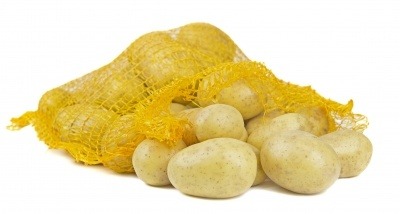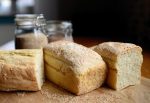
Starch is possibly the most important source of energy for feeding the world’s population. There isn’t a culture that developed to any extent without the ability to feed itself to a great degree using starch. It’s the key carbohydrate in plants, especially as it is their major energy store and one of our great sources of food. We have eaten plants primarily to provide us with their energy resources irrespective of the structural and health benefits they also offer. The small sugars which are derived from starch – the mono- and disaccharides are our principal sources of this energy as they feed into the various metabolic cycles that power our cells. You can’t really underestimate the role that starch has played throughout the course of human civilization. What is interesting to me in this short article is the resistant starch component.
Starches are long chains (polymers) of glucose which are found in potatoes but also cereals and legumes (Haralampu, 2000). Much of it is metabolised for energy – granted. Not all starch however is consumed however in the intestines. This portion or fraction is resistant to metabolism in the small intestine. In particular it forms for nutritionists an important component of dietary fibre, especially soluble fibre. It enters the large intestine where it ‘works its magic’ as a fermentation substrate (Mathers, 1992). It is commonly referred to as resistant starch (RS) and is now targeted by product developers to improve the fibre content of their products which in turn helps their nutritive value.
The Types Of Starch
For most purposes, starch can be broadly classified into three fractions. We have rapidly digestible starch (RDS), the slowly digestible starch (SDS) and the fraction we are interested in here – resistant starch (RS). The classification is based on the rates and extent of in vitro digestion according to the work conducted by the analyst Englyst (Englyst et al., 1992). The rapidly digestible starch (RDS) is converted to the small glucose units very quickly in the small intestine. It includes the gelatinised waxy starches. The slowly digestible starch (SDS) is digested completely but slowly in the small intestine.
The Benefits In Human Nutrition.
Human clinical studies have shown that resistant starch has great health benefits. Like many soluble fibres, resistant starch can help those with:-
(1) diabetes by improving insulin sensitivity and sustaining or reducing blood sugar levels. This is a general hypoglycaemic effect.
(2) reducing cholesterol levels (hypocholesterolaemic effect)
(3) help weight loss by improving the functioning of the digestive tract, and generating feelings of satiety and making us feel full and acting as a digestive ( Nugent, 2005; Sajilata et al., 2006)
(4) reduction of blood lipid levels.
Incidentally, lets not overlook the slowly digestible starches (SDS). The SDS starch fraction is probably more beneficial than resistant starch in many of the physiological conditions noted because its slow digestion means there is also a slow but sustained provision of glucose which means a less drastic elevation in blood glucose levels. We know the physiological benefits of SDS also include creating feelings of satiety, better tolerance to glucose, diabetes management and reduction in blood sugar lipids too.
Resistant starch has a very low glycaemic index for example. It is the form of starch which cannot be digested by human digestive enzymes alone but is fermented by our flora and fauna in the large intestine of our gut. RS is an important probiotic.

The Types Of Resistant Starch
There are four distinct types of starch, based on analysis, many of which are present together in a food (Englyst et al., 1992) :-
♦ Type 1 – a component of the plant cell walls and present in seeds and grains, legumes and general plant matter. It is physically inaccessible unless the grains and seeds are physically milled to make the starch more available.
♦ Type 2 – mainly found in raw starch granules such as raw or uncooked potatoes or green bananas and plantain, and the high amylose corn starches. One starch in this group called high-amylose maize resistant starch type 2 (HAM-RS2) looks to have particular promise in nutritional research.
♦ Type 3 – a starch generated by cooking and other forms of heat processing. Retrogradation is the process which produces this type of starch and is part of the staling process as well as critical for gel formation and for generating the cooked sensory qualities of a variety of foods.
♦ Type 4 – Derived by processing and artificially generated through chemical means. An important component of functional foods. Type 2 and 3 starches have been subject to many rapid advances in production (Thompson, 2000).
Type 5 – these cover two different components and are probably amylose-lipid complexes. These form during food processing or are created synthetically. It is thought that resistant maltodextrin can be restructured to produce different forms of starch that have yet to be fully characterised.
Cooking And Processing
In processed foods, RS is a major functional ingredient and has a low sensory impact compared to grains, fruits and bran (Fuentes-Zaragoza et al., 2010). The quantity and type of resistant starch changes as a plant product ripens. Unripe bananas for example have high level as the resistant starch which becomes more easily digestible as the banana ripens.
Baking, production of pastas and extrusion cooking all contribute to raising the RS content (Rabe et al., 1992). Resistant starch is also the form least likely to break down during processing although it does degrade with cooking. Deep fat frying and roasting are not as damaging to RS as slow braising (Chen et al., 2010).
What Happens In The Gut
The probiotic bacteria, which are found throughout the intestine have their greatest impact in the larger intestine and colon. We wish to promote their continued growth especially, because it helps us in the maintenance of our intestines by a variety of factors still being investigated . As with soluble fibre, resistant starch helps probiotic bacteria to grow and survive by allowing them to use the starch as an energy source.
Resistant starch helps ‘good’ bacteria to stick or adhere to the intestinal wall. It also slows the passage of food through the gut which improves digestion and increases the viscosity of the food especially as it passes to the lower intestines. This is one of its prebiotic functions (Topping et al., 2003).
One of their products is butyrate along with other short chain fatty acids (SCFAs) like propionate which have great bearing in maintaining good gut health. There is substantial evidence pointing to a reduction in colorectal cancers when diets promoting the generation of SCFAs are taken (Brouns et al., 2002). It is also the case that SCFAs modulate the effects of various growth factors in the gut
Butyrate is the preferred fuel for cells of the colon. Resistant starch as with other dietary fibres helps these colonic cells to thrive by promoting the production of butyrate (Brouns et al., 2002).
Reducing Intestinal Inflammation
One of the other consequences of good intestinal health is a reduction in the level of inflammation. This is associated with allergenic and chronic diseases like diverticulosis, and especially the bowel diseases like Crohn’s Disease and Ulcerative Colitis (Bird et al., 2000). It is known that with inflamed mucosa – the cells lining the intestines that butyrate stimulates the regeneration of the damaged and diseased portions of the gut. In precancerous cells, butyrate also inhibits proliferation at the crypt surface which is the site of potential tumour development. One other positive effect is to reduce constipation and diarrhoea.
It also helps to buffer the pH in various parts of the intestine although how critical this is may only be guessed at. An overly acidic pH is associated with inflammation.
Resistant Starch Makes You Feel Full
The satiety effect is important if we want to seek ways of reducing our weight. Resistant starch is only 2 calories per gram compared to regular starch which is 4 calories per gram. Encouraging the consumption of resistant starch over regular starch will certainly help in the overall plan for reducing obesity in the human population.
Mineral Absorption
There is some small evidence that RS helps with the absorption of various minerals (Morais et al., 1996).
Body weight, Weight Reduction And Appetite
Resistant starch has been shown to help reduce appetite and overall food intake but only in the short term. Whilst the evidence is being evaluated for these effects, there are mechanisms which RS is thought to be able to participate in. For example, the release of gut hormones promotes feelings of satiety which are stimulated by SCFAs. The evidence for the helping reducing body weight in humans is scant but one that promises much.
Improving Insulin Sensitivity
In 2014, a study was presented at the Annual Obesity week conference which suggested that a high-amylose resistant starch known as HI-MAIZE could improve insulin sensitivity in women. This study was building on earlier research concerning the benefits of diabetes management in women in particular.
The subjects were 43 healthy women who were either of typically normal weight or obese, either pre- or post-menopausal with an age range of between 22 to 68. The experimental design was randomized, placebo-controlled with a double-blind crossover structure. The ingredient, HI-MAIZE 260 corn starch was incorporated into snack foods. Two dose levels of 15g and 30g resistant starch per day were tested. The control was an isocaloric snack i.e. one which had the same energy content as the two snacks with the resistant corn starch but with a readily digestible waxy corn starch. All participants consumed snack foods over four-week intervals followed by a four-week washout period between the three test periods. An intravenous glucose tolerance test was administered at the end of each test period to check insulin sensitivity.
Snacks containing the high amylose resistant starch improved insulin sensitivity in the combined group of both pre- and post-menopausal women. That indicated that differences in hormonal state were not influencing the findings. The response was affected by baseline insulin sensitivity and waist circumference.
A small but significant subset of women had an unusually high insulin sensitivity and there was no improvement in this particular subset. In the remaining group of women, there was a 26% improvement in their insulin sensitivity after consuming those snacks containing 30g of resistant starch compared to the control. The effects were affected by waist circumference with notable improvements especially in women with bigger waists.
Sources Of Resistant Starch
We have already mentioned a number of starchy foods such as potatoes, bananas, cereals etc. Generally, tubers and legumes have very high RS contents.
Oats have long been thought of as excellent sources of dietary starch and are whole grains. We know that 3.6 grams of RS comes from 100g (about 3.5 oz.) of cooked oatmeal flakes. Oats also contain many different antioxidants.
Nuts contain RS. Peanuts, pistachios and chestnuts are good sources and it is likely other nut sources exist with equally good RS contents.
We mentioned legumes and beans. These on average contain between 1 and 4 grams of resistant starch per 100g when the product is cooked (Chen et al., 2010). Remember, all legumes and beans need to be soaked and cooked so as to remove anti-nutrition factors and lectins (Dolan et al., 2010).
Ripe bananas are healthy but green bananas have very high dietary fibre contents. The ripening process sees resistant starch convert into simple sugars such as glucose, fructose and sucrose. Bananas are also good sources of vitamin B6 and C. Nutritionists suggest green bananas are eaten to optimise on starch intake because of there excellence as a source of RS.
Baked potatoes are better than boiled potatoes for their resistant starch content. Baking is not as damaging to resistant starch as boiling. Likewise, chilled (4 °C) or cold potatoes (not raw) contain more resistant starch than hot (65 °C) or reheated potatoes (4 °C for 6d; reheated to 65 °C). Chilling allows for the formation of retrograded starch which is less easily digested than cooked starch (Raatz et al., 2016).
The Production Of Resistant Starch Type III (RS III)
Resistant starch Type III is now being manufactured for specific use as a food additive (Sajilata et al., 2006).
Resistant starch type III is manufactured in a two-stage process. It begins by hydration and gelatinization of starch where amylose is leached from starch granules into solution as a random coil polymer
Acids and enzymes are used to partially hydrolyse starch polymers. The second stage requires incubation of the material to allow the flexible linear amylose polymers to recrystallise as double helices and then form tightly packed helical or spherical structures stabilised by hydrogen bonds.
RSIII is a crystallization process of amylose, into enzyme-resistant double helices stabilised by hydrogen bonds, in a partially crystalline system
Enzyme-catalysed hydrolysis is preferred to acid-catalysed hydrolysis. Enzyme catalysis produces better yields, improved product quality and reduces energy consumption. The enzyme used include isoamylase or pullulanase to eliminate α-d-(1→6) glycosidic linkages of amylopectin (Chiu et al., 1994).
Consumption of Resistant Starch In Various Countries
The RS intakes throughout the world differs because of the type of diet adopted. Dysseler & Hoffem (1994) looked at 10 different European countries and levels in places like Italy (Brighenti et al., 1998), the USA (Murphy et al., 2008) and China (Chen et al., 2010) are now reported. The level of RS intake in Africa is the highest anywhere. They consume between 20 and 30 g every day (Cummings and Englyst, 1989).
1st revision – new data on resistant starches 8th August 2018.
References
Bird, A.R., Brown, I.L., Topping, D.L. (2000) Starches, resistant starches, the gut microflora and human health. Curr. Issues Intest. Microbiol. 1(1) pp. 25-37
Brighenti F, Casiraghi C, Baggio C. (1998) Resistant starch in the Italian diet. Brit J Nutr. 80 pp. 333-41.
Brouns, F., Kettlitz, B., Arrigoni, E. (2002) Resistant starch and “the butyrate revolution”. Trends Food Sci., Technol., 13 (8) pp. 251-261
Chen, L. Y., Liu, R. P., Qin, C. Y., Meng, Y., Zhang, J., Wang, Y., & Xu, G. F. (2010). Sources and intake of resistant starch in the Chinese diet. Asia Pacific Journal of Clinical Nutrition, 19(2), pp. 274-282 https://www.ncbi.nlm.nih.gov/pubmed/20460244
, & (1994). Process for making amylase resistant starch from high amylose starch. U.S. Patent, 5,281,276.
Dolan, L.C., Matulka, R.A., Burdock, G.A. (2010) Naturally occurring food toxins. Toxins (Basel) Sep; 2(9) pp. 2289-332 https://www.ncbi.nlm.nih.gov/pubmed/22069686/
Dysseler, P., Hoffem, D. (1994) Estimation of resistant starch intake in Europe. In Proceedings of the Concluding Plenary Meeting of EURESTA, April 1994. European Flair—Concerted Action no. 11 (COST 911), ed. N-G Asp, JMM van Amelsvoort, JGAJ Hautvast. pp. 84-6 .
Englyst, H.N., Kingsman, S.M. Cummings, J.H. (1992) Clasification and measurement of nutritionally important starch fractions. Eur. J. Clin. Nutr. 46 S33-S50
, , , & (2004). Resistant starch made from banana starch by autoclaving and debranching. Starch/Stärke, 56, pp. 495–499 (Article).
Haralampu, S.G. (2000) Resistant Starch- A review of the physical properties and biological impact of RS. Carbohydrate Polymers. 41(3) pp. 285-292
, , & (2000). Highly fermentable resistant starch. U.S. Patent, 6,043,229
, & (2002). Characterisation of resistant starch type III from banana (Musa acuminata). Journal of Agricultural and Food Chemistry, 50, pp. 5236–5240.
Mathers, J.C. (1992) Energy value of resistant starch. Eur. J. Clin. Nutr. 46 S129-S130
Maziarz, M., Sherrard, M., Juma, S., Prasad, C., Imrhan, V., Vijayagopal, P. (2012) Sensory characteristics of high-amylose maize resistant starch in three food products. Food Sci. Nutr. 1(2) pp. 117–124 https://onlinelibrary.wiley.com/doi/full/10.1002/fsn3.15
Murphy, M.M., Douglass, J.S., Birkett, A. (2008) Resistant starch intakes in the United States. J. Am. Dietetic Assoc. 108 pp. 67-8.
Nugent, A. P. (2005), Health properties of resistant starch. Nutr. Bulletin, 30 pp. 27–54. doi: 10.1111/j.1467-3010.2005.00481.x
Rabe, E., Sievert, D. (1992) Effects of baking, pasta production, and extrusion cooking on formation of resistant starch. Eur. J. Clin. Nutr. 46 S105-S107
Raatz, S.K., Idso, L., Johnson, L.K., Jackson, M.I., Combs, G.F. Jr. (2016) Resistant starch analysis of commonly consumed potatoes: Content varies by cooking method and service temperature but not by variety. Food Chem., 208 pp. 297-300 https://www.ncbi.nlm.nih.gov/pubmed/27132853
Sajilata, M.G., Singhal, R. S. and Kulkarni, P. R. (2006), Resistant Starch–A Review. Comprehensive Rev. Food Sci. Food Safety 5 pp. 1–17. (Article)
Thompson, D.B. (2000) Strategies for the manufacture of resistant starch. Trends Food Sci., Technol. 11(7) pp. 245-253
Topping, D.L., Fukushima, M., Bird, A.R. (2003) Resistant starch as a prebiotic and synbiotic: state of the art. Proc. Nutr. Soc. 62(1) pp. 171-176
Wang, X., Brown, I. L., Evans, A. J. and Conway, P. L. (1999), The protective effects of high amylose maize (amylomaize) starch granules on the survival of Bifidobacterium spp. in the mouse intestinal tract. J. Appl. Microbiol., 87 pp. 631–639. doi: 10.1046/j.1365-2672.1999.00836.x



This is one of your best articles.